
“This is a new kind of book,” proclaims the dust jacket of This Is On Me, and the statement is still true nearly seventy years later. There is yet, as far as I know, another book like this. Time magazine described it as “scrapbook-diary-letter-what’s it-autobiography.” The New Yorker called it “autobiography-cum-short-stories-cum-articles, complete with anecdotes, divertissements, and funny sayings.” Brush herself said that when she started working on the book, it was a “sort of a kind of an autobiography” and at the book’s very beginning, she refers to it as a “vast hodgepodge” and a “shambles.” What it is, more than anything else, is a memoir of Brush’s life as a working writer in the 1920s and 1930s, studded with great chunks of what she wrote.
Brush started working as a writer from the moment she left school. She wrote a daily movie column for the Boston Herald and Traveler, which she admits usually consisted of “short squibs which I clipped out of the press sheets sent out by the movie companies, and rewrote.” After a year or so, she married Stewart Thomas Brush, whose father owned a string of small-city papers, moved to Ohio, and gave up writing. For about two months. But then she bought a second-hand typewriter and started in again. She went back to rewriting movie publicity under the banner of “Prattle About Picture Plays by Barbara Blake.” “I am even afraid that I thought that up myself,” she confesses.
She started sending stories to magazines. Her method was straight-forward and efficient. She took down a list from The Manuscript Market Guide and started sending out manuscripts:
Enclosing stamped, self-addressed envelopes for return, I mailed the manuscripts out as fast as I wrote them; and as fast as they came back, which was as fast as trains could carry them, I ticked the name of each unappreciative market off on the list, and tried the next one. As the manuscripts began to show first signs of wear and tear, I ironed them out with a lukewarm flatiron (another helpful hint culled from the writers’ magazines). When the pages became really tattered I retyped them.
Eventually, Brush sold a bit of comical verse to American Golfer for $5.00. By the end of 1923, she’d made a total of $84.75–most of that thanks to her first story sale, for $50, to Yippy Yarns. In 1924, she suddenly hit her stride, selling a story titled “Pity Pat” (“Oops, sorry!” she writes) to College Humor. Over the next few years, she wrote over forty stories and two novels for College Humor, perfecting the worldly, wise-cracking comical sense that matched the spirit of “Raccoon coats, flapping galoshes, hip flasks, jazz, bobbed hair, petting and necking, flivvers, Flaming Youth, and Mr. Scott Fitzgerald.”
Her first novel, Glitter, written in installments for College Humor, was published in 1925, and Brush was launched into the world of book publicity:
And I learned about reviewers, clipping bureaus, copy-readers, Book Fairs, mistake-finders, and the sweetly well-intentioned people who seek to make an author’s heart rejoice by telling him that they have lent their copy of his book to nineteen friends, just think of it…. The author does just think of it. He broods, to put it bluntly. He says to himself, “Nineteen potential buyers gone to glory, well, that’s fine, that is.”
On the bright side, thanks to an industrious agent, Brush manages to sell Glitter eleven different ways:
American serial, book and movie–that made three. English magazine serial and English book–that brought it to five. Translations into German, Italian and Danish–eight. Newspaper reserialization in America–nine. The book was then reissued in a seventy-five cent (reprint) edition; this was a separate transaction, making ten. And more than a decade after the sale of the silent motion picture rightsm the talking picture rights (which hadn’t been provided for in the original contract because of course they hadn’t been dreamed of at that time) were sold. That was only last year, and it was divine, in a small way. Pennies from Heaven.
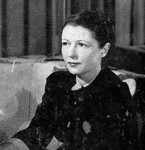 At the same time as she starting placing stories, Brush also started getting more substantial newspaper reporting jobs, thanks in part to her husband and father-in-law’s connections. Most importantly, though she didn’t think so at the time, was a string of sports reporting assignments, which included the 1925 World Series, college football games, and the Jack Dempsey-Gene Tunney heavyweight boxing championship fight. “I wasn’t much good on the Dempsey-Tunney fight story,” she admits, but a few years later she recycled the material to good effect as the opening to her biggest-selling novel, Young Man of Manhattan.
At the same time as she starting placing stories, Brush also started getting more substantial newspaper reporting jobs, thanks in part to her husband and father-in-law’s connections. Most importantly, though she didn’t think so at the time, was a string of sports reporting assignments, which included the 1925 World Series, college football games, and the Jack Dempsey-Gene Tunney heavyweight boxing championship fight. “I wasn’t much good on the Dempsey-Tunney fight story,” she admits, but a few years later she recycled the material to good effect as the opening to her biggest-selling novel, Young Man of Manhattan.
Stewart Brush got a job working for the New York Herald Tribune in 1926, and the couple moved to Manhattan just in time to catch the heyday of the Jazz Era. Katharine kept writing and selling, in part to keep up with the increased cost of life in the Big Apple. “I must make vast sums,” she told her mother, “and with no further delay.” Unfortunately, she found that, “Let me need money, really need it badly, and the only stories I can write will run to uncommercial themes, invariably.”
She produced a story called “Night Club.” Six editors in a row rejected it. “It’s all women.” “It has no central theme to hold the reader’s interest.” Then Harper’s accepted it in September 1927 and soon she was getting calls from other editors asking, “Wouldn’t you do us a story on the order of ‘Night Club’?” “Night Club” went on to become an anthology favorite through much of the late 1920s and 1930s–to the point that Brush complains that, “any letter I get with the name of a college or university on the upper left-hand corner of the envelope is going to be from the English professor of that college or university, who wants permission to use ‘Night Club’ in a textbook he is compiling.”
Stewart and Katharine Brush divorced in 1927. During a trip to Europe in 1928, she met Hubert “Bob” Winans, a stockbroker, and they married in 1929, a few weeks after the publication of Young Man of Manhattan. Honeymooning in Paris, they were greeted one morning with the news of Black Monday on Wall Street. Winans lost his job. For the next two years, they camped out on a couch and two chairs in the palatial apartment they had just bought before leaving for Europe. “All it needs,” quipped a friend, “is six or seven Cadillacs.”
Brush became the main bread-winner, which turned out to be a rare lucky break. Young Man of Manhattan was one of the top ten best-sellers of 1930, and her next book, Red-Headed Woman sold nearly as well and was made into a successful movie starring Jean Harlow. Brush tells a little anecdote about the writing of Red-Headed Woman:
Throughout the writing of the first half of the book, I didn’t know what the last half was going to be, and couldn’t decide. (And that’s what comes of letting short stories grow into novels, by the way.) But then one evening in a Broadway night club I heard a girl at the next table quote another girl as having said, “Just look at all these diamond bracelets–and I’ve only been in New York a year!” So there it was, in sixteen words, and that’s the way I wrote it.
Winans’ fortunes rebounded and soon the couple was able to buy a Connecticut house and regular trips back to Europe. But Brush hit a wall when it came to writing: “Now the novel I was trying to write from my restless seat in the lap of luxury was called Don’t Ever Leave Me–and it practically never did. It took me three whole years.” “Now the book progressed a little,” she writes, “and now it lay down in its tracks and wouldn’t budge, and now it crawled away somewhere and tried to die.” The book did not improve with age. Even though she did manage to finish it and get it published, Brush admits that “time and leisure and freedom from financial strain” did not prove the boons she expected them to be:
Any story becomes a habit, after its third year on the ways; it becomes a fixture there; and the wretched author has so long ago passed the point where he should have stopped fussing with it that now he simply can’t stop. He just goes on and on–and of course he thinks he’s improving it, but or course he isn’t doing anything of the sort. He’s just throwing extra monkey wrenches into what were once the works.
The experience left Brush drained. She eked out a couple of stories and took a couple of jobs writing stories for Hollywood. She started another novel and gave up after fifty pages. Finally, sitting in the Persian Room with John Farrar and Stanley Rinehart of Farrar & Rinehart and listening to Eddie Duchin playing, “Get Out of Town,” she pitched the idea for This Is On Me. It was going to be just a collection of new short stories. Farrar or Rinehart suggested she write some informal pieces to “tell the story of each story.”
When she started to write these introductions, however, bits of autobiography kept “creeping in.” Finally, the publishers gave in and what emerged was This Is On Me. Brush says she kept the “serious part” of her life out of the book, but “the rest is here.”
Early in her writing career, Brush sent some samples of her work to then-renown editor William Lyon Phelps, asking for his constructive criticism. “Dear Katharine,” he wrote back, “I have read your story and while it shows cleverness and skill I think you try to be too ‘snappy.'” It would be hard for the reader who makes it through the 400-plus pages of This Is On Me not to come to the same conclusion.
Many of the stories included in the book are very much relics of their time. One of the first in the book, “Football Girl,” was considered something of a comic masterpiece in its day. Today it’s merely stereotyped and silly. A number of others are just as bad. Brush’s other forte was the poignant glimpses of the human situation, like “Home,” about a boy returning from boarding school to divorced parents. These hold up better than the comic stories, but are not significantly better than the average magazine fiction from the time. At the time the book was published, Time’s reviewer thought the stories could just as well have been left out. After reading a few of them, today’s reader would have to agree.
Left on their own, however, the autobiographical sections would wear out their welcome, too. Brush seems so concerned with keeping up a steady stream of wisecracks and self-deprecating remarks that you want to shake her and yell, “Calm down!” at points. It’s almost disturbing at times. I kept thinking of pianist Roger Kellaway’s comment about his fellow musician, Frank Rosolino, who came to a very tragic end: “When somebody cracks four jokes a minute, we all should have known there was something wrong.” Katharine Brush was hardly suicidal, but her book would have been far more effective if she had been able to relax and not tried so hard to be “snappy.”
Still, this book is a fascinating account of how one writer made her way through two decades of professional ups and downs. Despite Brush’s sometimes strenuous comic tone, it’s the closest thing to a 20th century equivalent of Anthony Trollope’s Autobiography and a lot more fun.
Brush continued to work for over a decade after publishing This Is On Me. She published several more collections of stories, along with a collection of newspaper columns she wrote during the 1940s under the banner of “Out of My Mind.” She died in 1952 while undergoing surgery. Her son, Thomas Brush, helped establish the library that bears her name at Loomis Chaffee, a private school in Connecticut.
Locate a Copy
This Is On Me, by Katharine Brush
New York: Farrar & Rinehart, 1940
a try after coming across an enthusiastic Amazon.com review that called it “An Under-rated, lyrical ‘outsider-lit’ classic.” The reviewer, Benjamin N. Pierce, described the novel as,
was published in 1973, when every other college kid was reading Robbins or Vonnegut, and it’s hard to believe that Wallace’s novel didn’t attract at least a few of these readers, since it’s got just about all the ingredients one could ask for in college cult classic of that era: free love, great clouds of grass, drop-outs and outcasts from the Establishment, and even a big yellow schoolbus turned into a commune on wheels. Well, maybe not so hard to believe when you see that it was published by Bobbs-Merrill, whose neglect of Dow Mossman’s The Stones Of Summer
is recounted in Mark Moskowitz’s film, “The Stone Reader.”
is the tale of one man’s search for his place in the universe. P. R. Riffling is a very unhappy college instructor who spells his time playing “library games” such as searching for unusual stains (shoe polish, lamb chop grease, Kaopectate) and “lost book hunts”, locating books that had fallen behind and under shelves.
 Riffling realizes he is an Out-of-Sync, as is Miss Dunnette, the gorgeous red-headed librarian with whom he heads of on his journey. They soon locate Hafter’s former lover, Emma, a 70-year-old toker who still lives on the old farm where Hafter established Gallitzin College in the barn and pulled together a Utopian community of fellow Out-of-Syncs back in the 1920s. Fifty years ahead of its time, Hafter’s commune was awash in organic veggies, free love, and home-grown hemp, and everyone worshipped an enormous painting of a nude black woman with a sunflower bursting from her crotch.
Riffling realizes he is an Out-of-Sync, as is Miss Dunnette, the gorgeous red-headed librarian with whom he heads of on his journey. They soon locate Hafter’s former lover, Emma, a 70-year-old toker who still lives on the old farm where Hafter established Gallitzin College in the barn and pulled together a Utopian community of fellow Out-of-Syncs back in the 1920s. Fifty years ahead of its time, Hafter’s commune was awash in organic veggies, free love, and home-grown hemp, and everyone worshipped an enormous painting of a nude black woman with a sunflower bursting from her crotch. in the same fond regard as Mr. Pierce, but I did thoroughly enjoy it as a lovely bit of hippy-dippy nostalgia. And for any Out-of-Syncs out there: go get yourself a copy and discover the joys of mouth-popping, elbow-cracking, and chanting “Aljiri!”

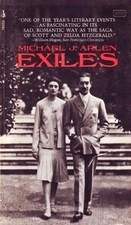
 Published in 2007,
Published in 2007,  “Why are so few novels remembered while so many thousands forgotten?” This is the question
“Why are so few novels remembered while so many thousands forgotten?” This is the question  Ah, there’s nothing like a dose of Georges Simenon to remind us of the worms lurking just beneath the surface of normality. He really was a master of finding that loose thread that can unravel the whole fabric of one’s existence with a simple tug.
Ah, there’s nothing like a dose of Georges Simenon to remind us of the worms lurking just beneath the surface of normality. He really was a master of finding that loose thread that can unravel the whole fabric of one’s existence with a simple tug.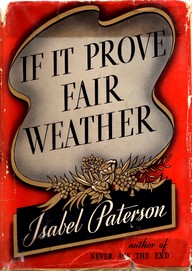 Paterson’s three novels published between 1933 and 1940–
Paterson’s three novels published between 1933 and 1940–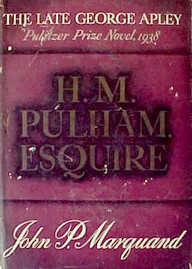 Compared to Ford, however, Marquand is more craftsman than artist. His prose style is never much more than workmanlike, and he has at time a tendency to fill pages more for the sake of providing his audience with a good thick read than for shaping his story. But observation, not artistry, is Marquand’s long suit. He is an ideal observer–a novelist of society, perhaps America’s best after Edith Wharton. Like Wharton, he is both immersed in society, having been raised in family highly sensitive to–if not highly placed in–Boston society, and able to detach himself and note its many ironies and shortcomings. And
Compared to Ford, however, Marquand is more craftsman than artist. His prose style is never much more than workmanlike, and he has at time a tendency to fill pages more for the sake of providing his audience with a good thick read than for shaping his story. But observation, not artistry, is Marquand’s long suit. He is an ideal observer–a novelist of society, perhaps America’s best after Edith Wharton. Like Wharton, he is both immersed in society, having been raised in family highly sensitive to–if not highly placed in–Boston society, and able to detach himself and note its many ironies and shortcomings. And 
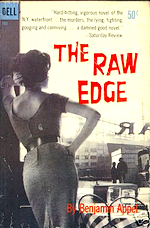
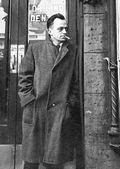 Appel’s career as a writer spanned five decades and his work ranged from serious fiction such as
Appel’s career as a writer spanned five decades and his work ranged from serious fiction such as 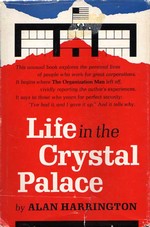
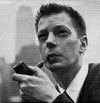 Late in his time at the Crystal Palace, Harrington prepares a number of suggestions aimed at injecting a stronger sense of accountability into the company’s way of working, but then tosses them aside, recognizing they had no chance of being adopted. He had become, in his own words, “a thoroughly tamed playboy.” “Spiritually, my net worth was zero.” Only a lucky offer from Cary McWilliams, editor of The Nation, to write about his experiences finally offers him a way out. The article, and a grant from the
Late in his time at the Crystal Palace, Harrington prepares a number of suggestions aimed at injecting a stronger sense of accountability into the company’s way of working, but then tosses them aside, recognizing they had no chance of being adopted. He had become, in his own words, “a thoroughly tamed playboy.” “Spiritually, my net worth was zero.” Only a lucky offer from Cary McWilliams, editor of The Nation, to write about his experiences finally offers him a way out. The article, and a grant from the 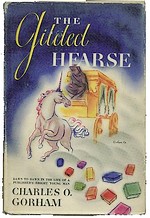 Brooks Peters, who writes one of the most consistently interesting blogs around (
Brooks Peters, who writes one of the most consistently interesting blogs around (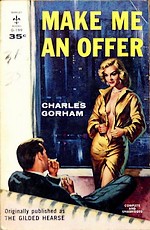
 Thanks to a visitor’s Amazon purchase, I discovered an admirable venture into republishing neglected classics:
Thanks to a visitor’s Amazon purchase, I discovered an admirable venture into republishing neglected classics: 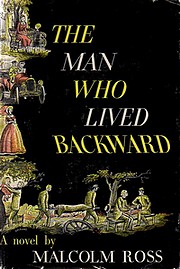 This is the most confusing book I’ve ever read. 400-plus pages and my head still hurts when I try to make sense of it.
This is the most confusing book I’ve ever read. 400-plus pages and my head still hurts when I try to make sense of it.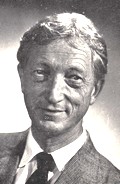 Fiction was not, I should note, Malcolm Ross’ forte. He spent most of his working life as a journalist and labor relations expert, serving as chairman of the Fair Employment Practice Committee through most of World War Two. His first book,
Fiction was not, I should note, Malcolm Ross’ forte. He spent most of his working life as a journalist and labor relations expert, serving as chairman of the Fair Employment Practice Committee through most of World War Two. His first book, 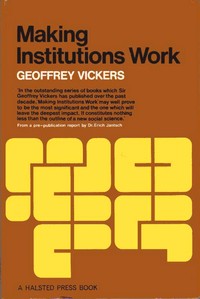
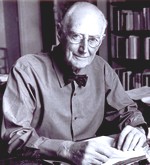 Sir Geoffrey Vickers led a remarkable life. He joined the British Army in 1914 and spent as much time as perhaps any other officer serving in the trenches on the Western Front, earning the
Sir Geoffrey Vickers led a remarkable life. He joined the British Army in 1914 and spent as much time as perhaps any other officer serving in the trenches on the Western Front, earning the  The
The 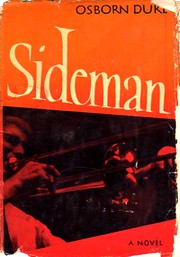 I probably would have filed
I probably would have filed 
 At the same time as she starting placing stories, Brush also started getting more substantial newspaper reporting jobs, thanks in part to her husband and father-in-law’s connections. Most importantly, though she didn’t think so at the time, was a string of sports reporting assignments, which included the 1925 World Series, college football games, and the Jack Dempsey-Gene Tunney heavyweight boxing championship fight. “I wasn’t much good on the Dempsey-Tunney fight story,” she admits, but a few years later she recycled the material to good effect as the opening to her biggest-selling novel,
At the same time as she starting placing stories, Brush also started getting more substantial newspaper reporting jobs, thanks in part to her husband and father-in-law’s connections. Most importantly, though she didn’t think so at the time, was a string of sports reporting assignments, which included the 1925 World Series, college football games, and the Jack Dempsey-Gene Tunney heavyweight boxing championship fight. “I wasn’t much good on the Dempsey-Tunney fight story,” she admits, but a few years later she recycled the material to good effect as the opening to her biggest-selling novel,